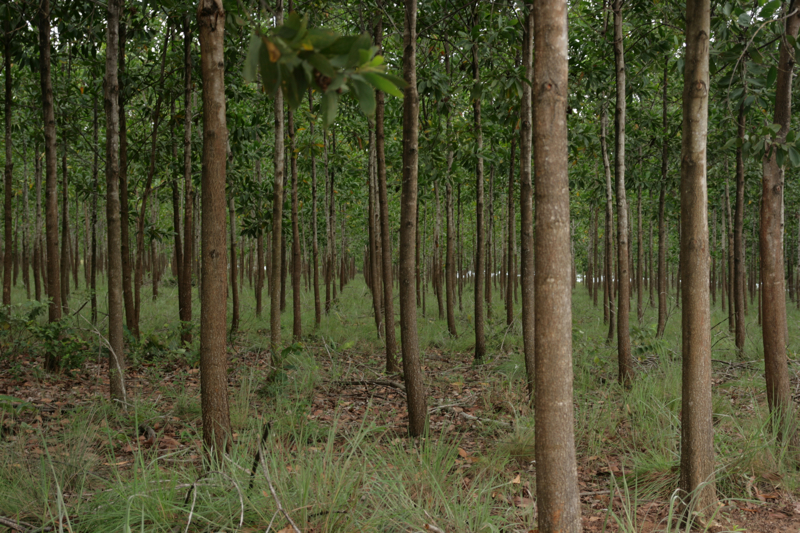The repeated claims by Sarawak government authorities that planting millions of plantation trees is ‘eco-friendly’, ‘green’ or ‘combating climate change’ are fake.
In fact, planting the wrong trees in place of natural forests is doing far more harm than good, according to a report from the world’s top botanists at London Kew Gardens, who are warning that huge care and consideration needs to be adopted by tree-growing projects to save the environment.
Sarawak Report is reproducing an item from the UK Daily Mail (below) and from the BBC for the benefit of Sarawakians who have been deluged with propaganda about the growing of millions of trees, which have time and again masked the reality of massive tree plantation plans sponsored by the state government.
So far, nearly all Sarawak’s fast-grow, foreign tree plantation projects have miserably failed to deliver timber and have ruined huge areas of tropical forest.
Just earlier this month we reported on the latest plan that has been slipped past the authorities and given approval, despite no information being made public on the environmental impact assessments.
The secretive project aims to rip out ten thousand hectares of natural growth forest in Kanowit to be replaced by an experimental, genetically modified, foreign Paulownia species.
The brand new lab plant has been barely tested in the wild but those behind the venture are plainly greedily excited by the allegedly super-fast growth boasted by the investors behind the new brand.
It will be of little surprise to people in Sarawak and the native dwellers of the land that the concession holder for the land (given to him for a peppercorn price from his Dad) is Abu Bekir Taib, son of the Governor.
The real profit for the company he controls, Polar Towers, will be from ripping out the natural hardwoods. He then hopes to regrow fast with the experimental GM crop. However, experts have warned that the fast grow Paulownia will likely fail to thrive in the foreign conditions given no small scale tests have yet been carried out
Moreover, it is widely warned that super fast grown wood has limited commercial value or practical use…. beyond the likes of matchsticks and chopsticks.
Worst of all is the environmental damage caused to the natural landscape and living forests by greedy, useless plantations:
“Planting large areas with only a few, non-native, species can push out wildlife, reduce the amount of carbon being stored in soils and the forests, and reduce the land available for crops – potentially causing more deforestation elsewhere.
is the damning conclusion.
As for the ‘go green’ claims about capturing carbon? The expert botanists from Kew Gardens warn that plantations like this produce MORE carbon emissions than they capture – a natural regrown forest however absorbs 40 Times as much as plantations.
Read the full article beneath:
Tree planting can be HARMFUL to the environment if the wrong species or location is chosen, scientists warn
[Daily Mail]

Tree planting can be HARMFUL to the environment if the wrong species or location is chosen, scientists warn [Daily Mail]
Tree planting can be harmful to the environment if the wrong species or location is chosen, a new study has warned.
Forests are essential to life on Earth, providing us with food, fuels and medicine, and soaking up carbon dioxide.
However, research indicates that an area around the size of Denmark of tropical forest is lost every single year.
Researchers say that poorly planned and executed tree planting schemes are actually doing more harm than good, and have proposed a set of 10 ‘golden rules’ for restoring forests.
The researchers hope their rules will be adopted by all nations this decade, and will help to restore precious forests in a way that benefits both people and the planet.
The researchers from the Royal Botanic Gardens, Kew (RBG Kew) and Botanic Gardens Conservation International (BGCI) are urging a ‘right tree in the right place’ approach to make sure restoring forests benefits people and the planet.
A study by the scientists found that in some cases, tree planting schemes did not increase the amount of carbon being stored in the landscape and could hit wildlife and people’s livelihoods.
Planting large areas with only a few, non-native species can push out wildlife, reduce the amount of carbon being stored in soils and the forests, and reduce the land available for crops – potentially causing more deforestation elsewhere.
But allowing areas of forest to naturally regenerate is cheaper and can create up to 40 times more potential for carbon storage than plantations, while picking the right trees and places for planting can help restore nature and boost people’s livelihoods.
The team’s 10 golden rules, set out in a paper published in the journal Global Change Biology, focus on protecting existing forests first, putting local people at the heart of projects, and using natural regrowth of trees where possible.
Schemes need to focus on the right area for reforestation – for example, on land which used to be forest and has become degraded, rather than other important habitats such as grassland.
Allowing areas of forest to naturally regenerate is cheaper and can create up to 40 times more potential for carbon storage than plantations. Pictured is an example of successful tree planting in Lampang Province, Thailand
Planting large areas with only a few, non-native, species can push out wildlife, reduce the amount of carbon being stored in soils and the forests, and reduce the land available for crops – potentially causing more deforestation elsewhere.
They should aim to maximise the recovery of nature to help wildlife and provide food, fibre and medicine for people’s livelihoods, as well as storing carbon.
Planting schemes must select the right trees, to attract nature such as monkeys that can disperse seeds and help the forest recover further, and make sure they are genetically diverse so they are resilient to future diseases and changes in the climate.
They also need to plan ahead, learn by doing – using local knowledge and small-scale trials where possible – and make sure forests provide income for people, through products they can sustainably harvest, ecotourism or environmental payments.
Dr Kate Hardwick, conservation partnership coordinator at RBG Kew, said: ‘Tree planting now dominates political and popular agendas and is often presented as an easy answer to the climate crisis, as well as a way for corporate companies to mitigate their carbon emissions, but sadly, it isn’t as simple as that.
‘When people plant the wrong trees in the wrong place, it can cause considerably more damage than benefits, failing to help people or nature.’
Professor Alexandre Antonelli, director of science at RBG Kew, said that forests were hugely important but were disappearing at an alarming pace.

It is ‘fantastic’ that thousands of people and businesses are planting trees, he said, adding, ‘it is a brilliant solution to tackle global warming and protect biodiversity, when done correctly and effectively’.
But the researchers want to challenge the way trees were being planted to maximise impact, he said.
‘And whenever there’s a choice, we stress that halting deforestation and protecting remaining forests must be a priority,’ he said.
Dr Paul Smith, secretary general at BGCI, said the 10 rules highlighted that planting trees was highly complex.
‘There is no universal, easy solution to a successful reforestation initiative given the extraordinary diversity of trees, forest types and the unique cultural and economic environments each forest is in,’ he said.
‘However, there are successful examples that we can learn from and develop further to build on current public and private interest in the topic.’
Also Read the BBC article

